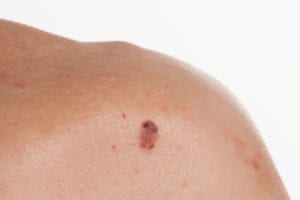It’s Just Squamous Cell Carcinoma
- Posted on: Apr 15 2018
Watch Videos About Mohs Surgery Here!
 The majority (80 percent) of skin cancer diagnoses made each year are related to basal cells, or BCCs. Diagnoses of squamous cell carcinomas, SCCs, occur less frequently but are by no means uncommon. It is essential that physicians and patients know how to recognize squamous cell carcinomas. Furthermore, it is important that these lesions not be lumped into the same “non-melanoma” category as basal cell carcinomas. Here, we want to discuss a few details about the second most common type of skin cancer.
The majority (80 percent) of skin cancer diagnoses made each year are related to basal cells, or BCCs. Diagnoses of squamous cell carcinomas, SCCs, occur less frequently but are by no means uncommon. It is essential that physicians and patients know how to recognize squamous cell carcinomas. Furthermore, it is important that these lesions not be lumped into the same “non-melanoma” category as basal cell carcinomas. Here, we want to discuss a few details about the second most common type of skin cancer.
Basal Cells and Squamous Cells: How they Differ
To understand the difference between BCCs and SCCs, we should look at the uniqueness of the cells in the skin. The epidermis, the top layer of the skin, is made up of melanocytes, basal cells, and squamous cells. Squamous cells live in the outermost layer of the skin. Lower beneath the surface are basal cells, which eventually come to the surface to replace squamous cells that are shed naturally. So, basal cells transform into squamous cells as they move up to the outer layer of the epidermis. Melanocytes are the cells that add color to the skin.
Call The ASMS Today to Learn More
How this affects carcinomas
What is interesting about basal cell carcinomas versus squamous cell carcinomas is that, while the squamous cells are located on the outermost layer of the epidermis, these cancers have the potential to grow deeper into the skin. Basal cell cancers rarely do so. Patients should be educated about what to look for during skin cancer self-exams to help them identify potential squamous cell carcinomas.
Typical characteristics of SCCs include:
- An open or recurring sore that alternates between bleeding and crusting.
- Elevated growths with a depressed center (like a volcano).
- Wart-like growths that occasionally crust or bleed.
- Scaly patches of red skin with irregular edges.
Diagnosis and Treatment
Routine skin cancer screenings are vital to the early detection of all types of skin cancer. In many cases, these exams reveal precancerous lesions called actinic keratosis. These lesions can be treated more easily without surgery. When symptoms of SCC or BCC are found, Mohs may be a strong contender for an optimal cosmetic outcome, as well as long-term prognosis.
The American Society of Mohs Surgery supports the medical community with shared knowledge among members, as well as educational courses. Learn more about these offerings at (800) 616-2767. If you are a patient looking for a Mohs surgeon in your area, visit our directory.
Want More Information? Contact Us Online
Posted in: Basal & Squamous Cell Carcinoma


